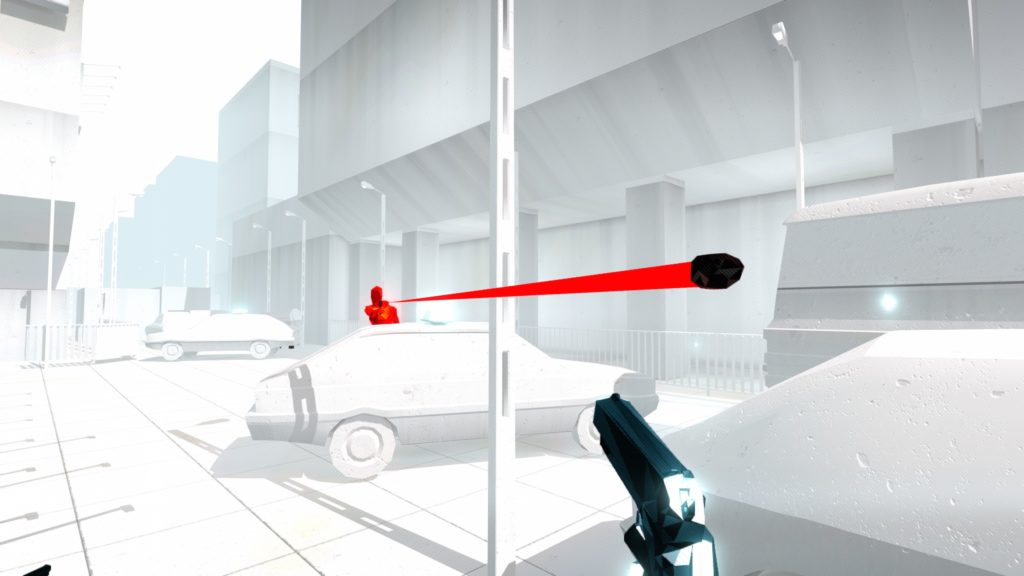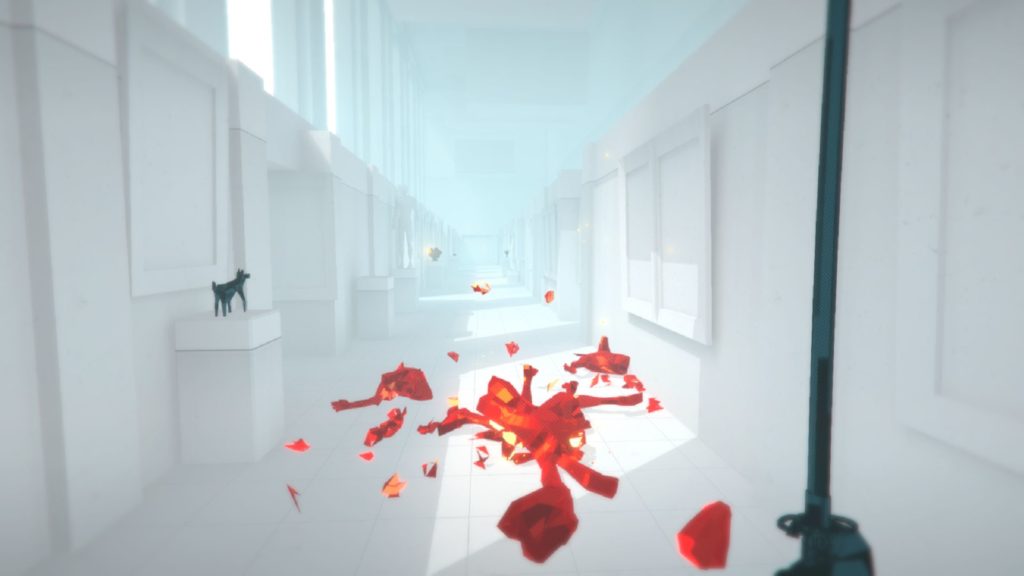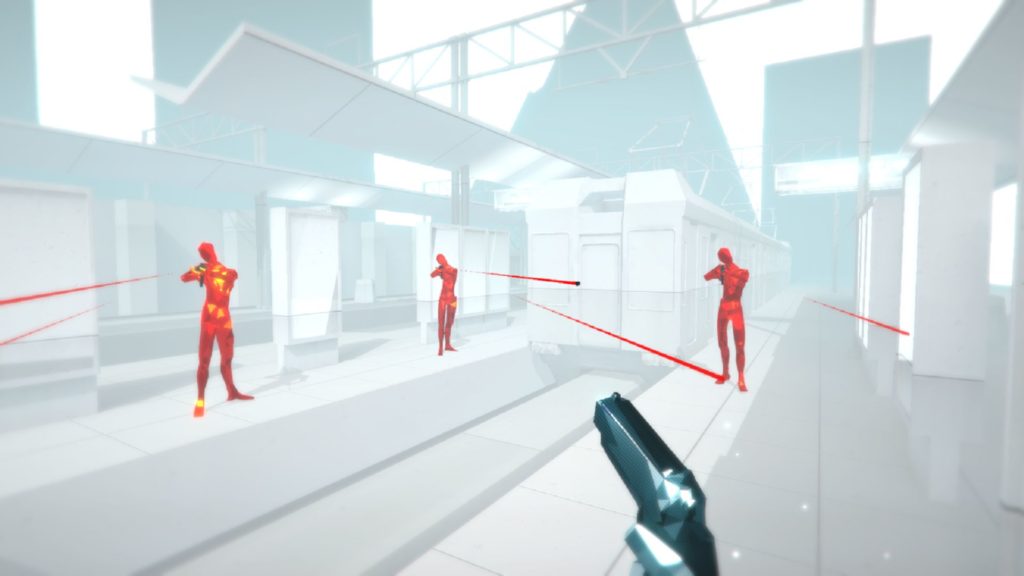Superhot provides the ultimate action movie challenge. Assailants come after player with a variety of weapons, but the action only progresses only move as the player moves. Time is otherwise frozen, giving players the chance to figure out a path to dodge all the bullets, reach their enemies, and take them out. It’s a challenging mix of strategy and action that made for the perfect demo when Oculus was showing the DK2 version of the Rift headset at conventions.
The regular, non-VR, version of the game released last February for PC and on Xbox One in May. While it enjoyed a great deal of critical acclaim, fans were left wondering when the virtual reality release would be coming. As it turns out, the developers—Superhot Team—had bigger plans in store. Instead of turning the existing game into VR, it decided to rebuild the game from scratch so that it would properly fit with the technology. Created in partnership with Oculus VR, Superhot VR was announced with an all-new trailer that revealed how it would support the upcoming Oculus Touch controllers for deeper immersion. However, the response wasn’t quite what the independent developer expected.
Tom Kaczmarczyk, co-founder of Superhot Team talks to [a]listdaily about working with Oculus to transition Superhot to VR, the challenges of working with a new platform, and some of the unpredictability involved.
Superhot VR is said to be completely re-imagined and redesigned experience. Can you go into detail about how the experience compares to the non-VR version?
It’s an intensely physical experience. More so than with most VR games, I would say. That feeling of intensity—of being in the center of the action that we focused on so much in regular Superhot—is now amped up to eleven in VR. You felt a bit like you were choreographing a badass action sequence every time you completed a level in Superhot. Well, now you physically need to go through the entire choreography yourself.
You feel 100 percent engaged, [and] it often gets tough as nails if you push yourself, but once you dodge that final bullet and smash the head off of that last remaining enemy with your own bare hands, you feel just exhilarated.
From a design perspective, we’ve got a lot of new locations and scenarios and there are even a few gameplay mechanics that emerge in VR that we wouldn’t have in a regular PC/console incarnation of Superhot. The entire story mode is now delivered differently. It erodes the borders between the realities in and outside of the headset and plays with your feeling of immersion in a rather dark, disturbing manner.
Why redesign Superhot for VR instead of porting the current game?
We started exploring VR way back in 2013. Oculus reached out to us even before our Kickstarter campaign, and we did a bunch of experiments around adding VR to our old browser-playable prototype. We were pretty much at the wild, uncharted forefront of VR development at that time.
After the first batch of prototyping and research, it very quickly turned out that a naive, one-to-one VR adaptation of Superhot simply would not cut it.
You often imagine that shooters in VR are going to be among the coolest experiences ever. You expect that games will just drop players into Quake-like mayhem, give them virtual rocket launchers and have everyone instantly run and jump around like it’s 1996 but in VR. As it turns out, that’s about as far from the actual experience as you can get. The range of motions available to players in VR is vastly different from regular games. You put a player in VR and suddenly he’ll be able to crawl, sidestep, look around corners and shoot from behind cover, but he won’t be able to walk freely without feeling ill.
It’s a much, much greater difference in a FPS than in any other genre. Board games, platformers and TPP (third-person perspective) games can be VR-ified fairly one-to-one. VR FPS (first-person shooter) games need to be designed with VR in mind from day one, or they just feel wrong.
So back in 2014, we found one part of the Superhot experience that worked really well in VR and shipped it as a 5 minute tradeshow demo for E3 for Oculus DK2. It was loads of fun; people loved it, and the extra publicity gave a huge boost to our Kickstarter campaign. It also opened our eyes to how much more research we needed to do before we could create a truly satisfying Superhot experience for VR that spans beyond that 5-minute demo.

What are the challenges in promoting Superhot VR compared to the non-VR version?
Ooh, that’s a funny one. Turns out we showed up with our VR announcement right in the middle of a very emotional discussion around VR platform exclusivity. Sort of like the darkest time in that Community episode with Troy bringing pizza just to find everything inexplicably on fire.
We started teasing and released a short gameplay trailer for Superhot VR at the beginning of June. We expected cheers and excitement that Superhot VR is a tangible title and that it’s being treated with the care and budget it needs to flourish. What we didn’t know is that apart from reaching our usual terrific bunch of players and followers, the timed-exclusivity also inadvertently triggered a negative reaction from a super-vocal group of PC Master Race gamers.
Before we had a chance to react and properly explain why we needed a timed-exclusivity agreement with Oculus, pretty much all of our social channels got set on fire.
It took a while for the discussion to die down. We went super transparent and put a lot of spotlight on the developer’s side of the story; we talked a lot with some of the more vocal anti-exclusivity activists, but it’ll still take a truckload more time for all the damage to heal after that short period of aggressive brigading.
Generally speaking—blissfully running a controversial announcement head-on against an emotionally loaded bunch of highly engaged gamers: 3/10. Would not recommend.

In the long run though, we’re hoping to get people as excited as we are about the VR incarnation of Superhot. It’s such a tremendous amount of poetically abstract, exhilarating violence and pure physical fun that it’d be a pity if there were VR players who overlooked the experience. We’re still figuring out how to best convey that immersive gameplay experience in regular trailers and videos, and that’s a rather tough cookie to crack. How do you talk and convey the emotions and the intensity you feel while playing Superhot in VR to a player who hasn’t played anything in VR yet? We’re still scratching heads and looking for good answers.
How has Oculus helped in developing and promoting the game?
On the most basic level, Oculus provided the funds and resources that we needed to be able to afford to make Superhot VR from scratch instead of lowering the bar and just gluing VR support onto regular Superhot. The actual involvement goes a lot deeper, though.
Our relationship with Oculus started a lifetime ago, back in 2013. Oculus reached out to us even before our Kickstarter campaign, and we became good friends throughout the years of developing “regular reality” Superhot. We bounced a lot of different concepts and spent a scary amount of time figuring out how to do proper VR FPS design. Once we got close to releasing Superhot on PC, we took a short breather, considered our options and decided on a hardline—forget porting and just redesign Superhot for VR from scratch.
Since we understood how much effort, expertise and money we’d need to throw to make this a truly excellent title, we poked Oculus, figured out a way to make the arrangement work together and have been using their swaths of VR experience ever since.
Will Oculus Touch controllers be required for Superhot VR?
At first, yes. It’ll work with other hand tracking controllers a short while after release, though. We’re thinking about VR gamepad support as well, but that’s definitely not coming until later.
What do you think are some of the biggest challenges for mass adoption of VR technology right now?
From a developer’s perspective, I see a very strong chicken and egg problem here. It’s near-impossible to produce high-quality titles for VR when there’s only around 100,000 people with headsets out in the wild. The market is tiny, compared to consoles or PC. Using only expected sales revenue to finance development, budgets simply don’t add up if you’re hoping to create anything larger than a short experimental experience or a proof of concept. You simply can’t make a responsible decision as a studio head to commit your company to a large VR production without external financing.
At the same time, the lack of high-quality VR games does not really inspire mainstream players to buy into VR just yet. Most gamers aren’t particularly excited about technology just for technology’s sake. They’re excited about what they can do with it and what games can they play. Right now, it’s tough for most mainstream players to feel excited about any of the currently available VR games enough to rationalize spending $700 on a VR kit.

On the one hand, we have the economies of game development prohibiting studios from making high-budget games for our fledgling VR market. On the other hand, we have the lack of high-budget games prohibiting gamers from flocking to VR and expanding the market. This vicious circle is super limiting to the rate at which VR is adopted organically.
Knowing that, we’re seeing a very strong commitment from platform owners to leapfrog a decade of organic growth by throwing money at the problem and bankrolling high-budget, high-marketing VR titles right now. There’s nothing inherently wrong with that, and I’m fairly certain that’s the best shot we’ve got at getting VR mainstream by 2020. At the same time, that means that most if not all of high-budget games available for VR for the next couple of years will be handpicked and groomed by just a few tiny groups of people working for platform owners.
Since it’s just a handful of hardworking, well-meaning people stuck doing gatekeeping for an entire ecosystem, we’re running a risk of excellent and innovative game ideas never getting realized simply because they’ll never manage to get properly pitched to those guys. Be it because the developer is in the wrong geography, the genre isn’t really a favorite for the reviewer or because maybe the reviewer just had a bad day. The situation will improve as the market matures and publishers and investors join the fray, giving devs lots more options to pitch their concepts. But for the time being, it’ll be tough for some devs to find enough resources to realize their creative visions.
Fingers crossed we’ll no longer have that problem in a year or two.

